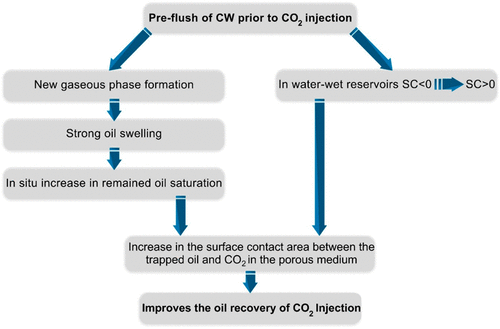当前位置:
X-MOL 学术
›
Ind. Eng. Chem. Res.
›
论文详情
Our official English website, www.x-mol.net, welcomes your
feedback! (Note: you will need to create a separate account there.)
Assessing the Feasibility of Improving the Performance of CO2 and CO2–WAG Injection Scenarios by CWI
Industrial & Engineering Chemistry Research ( IF 3.8 ) Pub Date : 2018-08-21 , DOI: 10.1021/acs.iecr.8b02000 Mojtaba Seyyedi 1, 2 , Mehran Sohrabi 2
Industrial & Engineering Chemistry Research ( IF 3.8 ) Pub Date : 2018-08-21 , DOI: 10.1021/acs.iecr.8b02000 Mojtaba Seyyedi 1, 2 , Mehran Sohrabi 2
Affiliation

|
In water-wet systems, the oil recovery performance of CO2 and CO2–WAG injection scenarios is negatively affected when the injection pressure is below the minimum miscibility pressure and the spreading coefficient is negative. Under these conditions, the bypassed oil in the porous medium will have the minimum surface contact area with the injected CO2. Thus, injection strategies that can improve this contact can enhance the CO2 performance. This study aims to quantify the impacts of injecting carbonated water (CW) prior to CO2 injection on oil recovery by CO2 and CO2–WAG injection scenarios. For this aim, a series of integrated high-pressure and high-temperature coreflood, micromodel and IFT experiments were performed using live crude oil. Coreflooding tests indicate that the preflush of CW improved the sweep efficiency of CO2 injection by 6.6% of the original oil in place. According to micromodel experiments performed under the condition of coreflood tests, during CWI period, CO2 partitioning from CW into the remained oil led to oil swelling, which in turn led to an increase in the remained oil saturation. Oil swelling also led to rupturing of the water layers shielded isolated oil ganglions and thus reconnection of isolated oil ganglions. Due to these changes, more oil will be accessible to the CO2 stream which in turn can favor the CO2 recovery performance. More importantly, IFT experiments showed that the preflush of CW impacts the interfacial tensions between the fluids (oil–water–CO2) and the spreading coefficient. Preflush of CW shifted the spreading coefficient from a negative value to a positive value. In a water-wet system, this shift maximizes the oil spreading or surface contact area between the CO2 and oil, and consequently favors the oil recovery performance of CO2 injection.
中文翻译:

通过CWI评估提高CO 2和CO 2 –WAG注入方案性能的可行性
在水湿系统中,当注入压力低于最小混溶压力且扩散系数为负时,CO 2和CO 2 -WAG注入情景的采油性能会受到负面影响。在这些条件下,多孔介质中的旁路油与注入的CO 2的表面接触面积最小。因此,可以改善这种接触的喷射策略可以提高CO 2性能。本研究旨在量化在注入CO 2之前注入碳酸水(CW)对通过CO 2和CO 2采油的影响– WAG注入方案。为此目的,使用活原油进行了一系列综合的高温高压岩心驱替,微模型和IFT实验。岩心驱替测试表明,连续水的预驱替将CO 2注入的扫除效率提高了原位原油的6.6%。根据在岩心驱替测试条件下进行的微模型实验,在CWI期间,CO 2从CW分配到剩余油中导致油溶胀,进而导致剩余油饱和度增加。油溶胀还导致被隔离的油性神经节的水层破裂,从而使隔离的油性神经节重新连接。由于这些变化,CO 2将可获取更多的油。气流,这反过来又有利于CO 2的回收性能。更重要的是,IFT实验表明,连续波的预冲洗影响流体(油-水-CO 2)之间的界面张力和扩散系数。CW的预冲洗使扩频系数从负值变为正值。在水湿系统中,此偏移使CO 2和油之间的油扩散或表面接触面积最大化,因此有利于CO 2注入的采油性能。
更新日期:2018-08-21
中文翻译:

通过CWI评估提高CO 2和CO 2 –WAG注入方案性能的可行性
在水湿系统中,当注入压力低于最小混溶压力且扩散系数为负时,CO 2和CO 2 -WAG注入情景的采油性能会受到负面影响。在这些条件下,多孔介质中的旁路油与注入的CO 2的表面接触面积最小。因此,可以改善这种接触的喷射策略可以提高CO 2性能。本研究旨在量化在注入CO 2之前注入碳酸水(CW)对通过CO 2和CO 2采油的影响– WAG注入方案。为此目的,使用活原油进行了一系列综合的高温高压岩心驱替,微模型和IFT实验。岩心驱替测试表明,连续水的预驱替将CO 2注入的扫除效率提高了原位原油的6.6%。根据在岩心驱替测试条件下进行的微模型实验,在CWI期间,CO 2从CW分配到剩余油中导致油溶胀,进而导致剩余油饱和度增加。油溶胀还导致被隔离的油性神经节的水层破裂,从而使隔离的油性神经节重新连接。由于这些变化,CO 2将可获取更多的油。气流,这反过来又有利于CO 2的回收性能。更重要的是,IFT实验表明,连续波的预冲洗影响流体(油-水-CO 2)之间的界面张力和扩散系数。CW的预冲洗使扩频系数从负值变为正值。在水湿系统中,此偏移使CO 2和油之间的油扩散或表面接触面积最大化,因此有利于CO 2注入的采油性能。











































 京公网安备 11010802027423号
京公网安备 11010802027423号